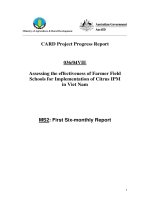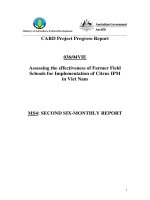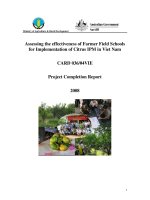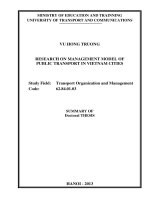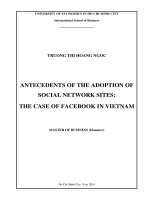Vulnerability & Adaptation Assessment examples of methodologies used in Viet Nam
Bạn đang xem bản rút gọn của tài liệu. Xem và tải ngay bản đầy đủ của tài liệu tại đây (313.92 KB, 18 trang )
Vulnerability & Adaptation
Assessment: examples of
methodologies used in Viet Nam
Koos Neefjes, UNDP-Viet Nam
22
nd
Asia-Pacific Seminar on Climate
Change, 27-28 June 2013
1
Contents
1. Introduction: VRA, V&A, and related
methodologies
2. CBA projects in Viet Nam: VRA and the H-
form
3. Gender and climate change field research in
Viet Nam
4. Climate change, migration & resettlement
field research field research in Viet Nam
5. Conclusions
2
1. Introduction (a)
• Need to understand vulnerabilities and best cc
adaptation actions, over time
• Need to understand impacts of projects
• Many methodologies, in climate change adaptation
and the Disaster Risk Management communities of
practice
• These communities of practice are working together –
e.g. IPCC’s SREX
• SERX : Disaster Risk is a function of Weather and
Climate Events (hazards), Vulnerability, and Exposure
• The communities of practice produce a lot of specific
and relevant guidance; UNDP is active in this too
3
1. Introduction (b)
• This presentation: usefulness of various methodologies
applied in three examples in VN.
• Our analysis should inform also the SREX-Viet Nam
• Part 2 is about Vulnerability Reduction Assessment
(VRA) for M&E in the SGP-GEF CBA program in VN
• For research we applied “mixed methodologies”, with
elements from different approaches : Part 3 on gender
& CC; Part 4 on Migration, resettlement & CC
• Part 5 gives summary of conclusions e.g. re the need to
adjust methodologies to the specific aims of the
exercises; and resource limitations
4
2. CBA projects in Viet Nam: VRA and
the H-form (a)
• Vulnerability Reduction Assessment (VRA) is applied in GEF-SGP
CBA projects, through project lifetimes
• Designed “to measure the changing climate vulnerabilities of
communities, and to be comparable across vastly different projects,
regions, and contexts, making it possible to determine if a given
project is successful or unsuccessful in reducing climate change
risks”.
• Four fixed indicators:
1. Vulnerability of livelihood/welfare to existing climate change /climate
variability
2. Vulnerability of livelihood/welfare to developing climate change risks
3. Magnitude of (policy, technological, financial) barriers to adaptation
4. Ability and willingness of community to sustain project intervention
• Each indicator is addressed with key questions that need to be
discussed and scored.
• This is summarised on the “H-Form”:
5
2. CBA projects in Viet Nam: VRA
and the H-form (b)
6
2. CBA projects in Viet Nam: VRA
and the H-form (c)
• The first VRA meetings preceded by CC awareness raising. Scientific knowledge is
combined with perceptions, to “remove biases”
• The baseline scores of local perceptions of project effectiveness in the first VRA is
followed by 3-4 VRAs over the lifetime of a project. Scores should “be a reflection
of the previous discussions”, with the same informants.
Analysis of practice in Viet Nam, and critique on VRA
• Individual CBA projects need M&E, and data from all projects must be aggregated
for analysing trends over wider geographic areas
• However, without experienced external facilitation the H-form is perceived as
complex by local stakeholders.
• Communities in VN without substantial external facilitation were confused about
the numerical data required, i.e. the scores on the H-form
• Furthermore, fully eliminating biases that influence the scores is impossible. Biases
are different per individual and group, and different moments.
7
2. CBA projects in Viet Nam: VRA
and the H-form (d)
• Ranking of data may be easier to do without skilled facilitation and may
produce more trustworthy data. Ranking can be applied to compare the
properties of different indicators (variables) at a certain time, and the
property of single indicators (variables) at different moments.
• Ranking data can also be quantified across geographies for aggregation of
results of projects:
– Indicator x shows a positive trend over time (ranking of different moments
shows it is ranked progressively higher at the later dates), in m projects
– Indicator y ranks highest amongst all indicators (most improvement as a result
of the project) in post-project assessments compared to other indicators, in n
projects
• Concepts: is exposure part of vulnerability or essentially a separate factor
(as in SREX)? The answer changes the main aim (towards: have climate
risks reduced over the lifetime of a project?) and predetermined
indicators (look separately at changes in vulnerability and exposure of
men & women, households, communities, infrastructure, ).
8
3. Gender and climate change field
research in Quang Tri province (a)
• Commune in a coastal district and in upland ethnic minority district
• Hypothesis: Climate change impacts and responses may enhance gender
inequalities , and failing to improve the status, livelihood opportunities and
resilience of women and girl children.
• Experienced researchers, with trained local facilitators
• Collection of (local) secondary data
• Use of matrix-tools , self-assessment of gendered vulnerabilities and resilience,
including “retrospective ranking” of households
• Focus group discussions (FGDs) at commune, district and province
• Household semi-structured interviews (SSIs) on climatic disasters experience; and
on gendered vulnerabilities and resilience
• FGDs and SSIs preceded by presentation of potential CC impacts in order to
discuss perceived future impacts and possible adaptation actions
• Cross checks between results of FGDs, SSIs and secondary information
• Scale. One FGD in province, districts , communes (total 150 participants); 2
schools (40 children). 63 household SSIs
9
3. Gender and climate change field
research in Quang Tri province (b)
Analysis of practice in this study, and critique
• Focused on cc-gender links, not project M&E. But data give baseline of
perceptions of vulnerabilities and adaptation options
• Used hypothesis and analytical framework to guide questions
• Indicators of vulnerability and resilience not pre-determined but came out
– Household vulnerability correlates with quality of housing
– Livelihood vulnerability b/c of lack of labour, tools, capital, land; &
dependency rate
– Location determines risks, or vulnerabilities & resilience
– Not all vulnerable households are poor, but poor households more vulnerable
– Resilience increases with social capital and disaster experience. Divorced
women have low resilience - often get limited social support
– Gender stereotypes may be reinforced by DRM actions.
– Women’s representation still low and CCA programs often “gender blind”. To
undertake typical male responsibilities increases resilience but also workload
10
3. Gender and climate change field
research in Quang Tri province (c)
• The methodology was related to VRA, but no H-form, no pre-set
indicators, no scoring. Comparing with other situations only qualitative
• To help participants relate aspects of their lives and livelihoods to impacts
of climate change, an introduction to climate change effects on locality
was given. This reduces biases (as in VRA) and enabled local analysis of
future CCA actions, but that cannot be only basis for CCA actions.
• The aim of the research and limited resources available had a strong
effect on the methodology and scope.
• The locations were typical for certain climate change impacts and social
economic conditions, but the data can only be extrapolated to similar
situations and not to all situations in Viet Nam. Conclusions from the
limited number of communities and interviewees must be qualified.
• The findings are evidence in addition to other studies, and provide
conclusions on linkages between gender relations and climate change
stresses as well as climate change responses.
11
4. Climate change, migration &
resettlement in the Mekong Delta (a)
• Communes in up-stream Mekong Delta (Long An and Dong Thap
provinces), with flood and erosion risks; & with resettlement sites.
Migrant-receiving areas in Ho Chi Minh City and Can Tho City.
• Objectives: examine household migration strategies in response to
environmental stress and how they affect resilience; identify ways
to strengthen resilience of communities under environmental
stress, improve resettlement, and minimize barriers to migration
• Research questions included:
– What is the interaction between environmental stress and
vulnerability, and what are adaptation strategies?
– To what extent is migration a coping and adaptation strategy for
households exposed to environmental stress?
– How do resettlement programs for flood and disaster-prone areas
affect resilience of livelihoods, well-being?
12
4. Climate change, migration &
resettlement in the Mekong Delta (b)
• Methods included: (a) structured surveys; (b) in-depth interviews (IDI); (c)
focus group discussions (FGD); and (d) key informant interviews (KII).
Quantitative data from the surveys were used, and other data used to
understand relationships between survey variables.
• Scale. 188 survey-interviews in rural sites, 200 in resettlement sites, 200 in
cities. 36 IDIs in resettlement sites, and 18 each in rural areas and cities.
Six FGDs in resettlement sites, and four each in rural areas and cities.
• Questions (survey, FGDs, IDIs, KIIs) based on an analytical framework
• Focus on poor and near-poor households, who are most vulnerable to the
environmental stress.
Analysis of practice in this study, and critique
• Random sampling was not fully possible in the surveys; purposive
sampling for IDIs and FGDs.
• OK scale but only extrapolate findings to very comparable situations
• The different research methods could not be pre-tested
13
4. Climate change, migration &
resettlement in the Mekong Delta (c)
• Thematic research not related to project M&E or baseline for projects but
is related to a large scale (Government) resettlement program
• No fixed or pre-determined indicators, but research questions, survey and
interview questions based on an analytical framework
• Findings on certain variables can be assessed in other situations:
– The main drivers for migration were lack of employment and low income
– Environmental stress affects livelihoods and can be a driver in itself
– Owners of land or housing less inclined to migrate, more likely to return
– Early Warning systems are in place in rural areas, and aid after disasters
– Living conditions in resettlement sites better than former rural areas. But
resettlement left poor and near-poor households often in debt
– Process of resettlement lacks community participation and transparency
– Social networks in sending and receiving areas are vital to migration
– Remittances to sending areas, also financial assistance to migrants
– The standard of living in the cities is better, but migrants have less access to
services
14
4. Climate change, migration &
resettlement in the Mekong Delta (d)
• The methodology was related to VRA, but no H-form, no pre-set
indicators, no scoring. Qualitative comparing with other situations
• The aim of the research and limited resources available had a strong
effect on the methodology and scope
• No introduction to climate change effects to localities, no attempts to
reduce biases or study local perceptions of future CCA. The focus was on
“environmental stresses”; links between climate change, migration and
resettlement can only be inferred from expert analysis
• Used an analytical framework that guided questions but e.g. questions
about women and men’s influence over decisions were not prominent –
the focus was on drivers of migration of households, women and men.
• Reasonable scale and some data can be analysed for comparisons of
quantified variables. But not a large survey or fully random samples so
cannot extrapolate to significantly different situations, regarding linkages
between environmental stresses, vulnerability and mobility.
• The findings from the field work are evidence in addition to other studies
15
5. Conclusions (a)
• The aim of research or M&E affects the methodology. Generating
insights in causal relations is different from generating data for
justification of project activities.
• Project M&E demands standardisation of indicators between
projects with similar aims, and over project lifecycles. Analytical
frameworks guide research questions and analysis of data in
thematic research, often leading to non-standardised indicators/
variables. However, the latter can often be related to and
qualitatively compared with similar research in other realities.
• Local conditions affect the methodology. For example random
sampling may not fit local realities; urban migrants are difficult to
meet; language barriers with ethnic minorities. In particular, local
(M&E) data with limited external facilitation must use
straightforward methods.
16
5. Conclusions (b)
• The need to draw conclusions over larger geographic areas and project
portfolios demands comparability of indicators. However, numerical
representation of trends in projects and over project portfolios does not
strictly require scoring of qualitative properties, which is affected by
informant biases. Ranking-data may be less affected by (changing,
different) biases of informants and can also be aggregated.
• E.g. “retrospective ranking” of household vulnerabilities and resilience /
capacities can be a powerful tool in both thematic research and project
M&E.
• Forward looking assessment of adaptation options is needed, and
facilitated by external inputs re climate change effects. This is not strictly
speaking research or project M&E, but valuable
• Research and M&E aims, methodology and scope are limited by human
and financial resources, and time. Because of resource limitations
knowledge must be built up as part of wider efforts to assess, evaluate,
research certain phenomena and program or project results. Perfection is
not possible and it is important to settle for approximate understanding
17
References
Care International (2009). Climate Vulnerability and Capacity Analysis Handbook
Chun, Jane M., and Le Thanh Sang (2012). Research and policy dialogue on climate change, migration and resettlement in Vietnam Final
Report. Report under the UNDP-MARD project “Strengthening institutional capacity for Disaster Risk Management in Viet Nam,
including Climate Change related disasters”.
Crane Droesch, Andrew, Nickey Gaseb, Pradeep Kurukulasuriya, Andre Mershon, Katiella Mai Moussa, Dale Rankine, Alejandro Santos (2008).
A Guide to Vulnerability Reduction Assessment, Working Paper, UNDP Community-Based Adaptation Programme
IIED (2009). Participatory Learning and Action 60: Community-based adaptation to climate change, London: IIED
ISIS (no date). Gender and Climate Change – Toolkit for women on climate change, Quezon City, Philippines: ISIS
IUCN, UNDP, GGCA (no date). Training manual on gender and climate change. International Union for Conservation of Nature (IUCN), United
Nations Development Programme (UNDP), Global Gender Climate Alliance (GGCA).
Lim, Bo, and Erika Spanger-Siegfried (eds) (2004). Adaptation Policy Frameworks for Climate Change: Developing Strategies, Policies and
Measures, Cambridge: Cambridge University Press with UNDP
MARD-UNDP (2012). Training material disaster risk reduction and climate change adaptation. Ministry of Agriculture and Rural Development
(MARD), United Nations Development Programme (UNDP)
UNDP (2009). Resource Guide on Gender and Climate Change, United Nations Development Programme (UNDP)
UNDP (2010). Designing Climate Change Adaptation Initiatives: A Toolkit for Practitioners, United Nations Development Programme (UNDP)
Bureau of Development Policy Bureau of Development Policy
UNDP (2010). Mapping Climate Change Vulnerability and Impact Scenarios: A Guidebook for Sub-National Planners, United Nations
Development Programme (UNDP).
UNDP Viet Nam and Oxfam Viet Nam (2009). Gender and climate change in rural Viet Nam - Results of research in three districts, DRAFT – 26
October 2009
UNFCCC (no date). Handbook on Vulnerability and Adaptation Assessment, Consultative Group Of Experts On National Communications from
Parties Not Included In Annex I To The Convention (CGE)
VKH-KTTVMT (2011). Tài liệu hướng dẫn đánh giá tác động của biến đổi khí hậu và xác định các giải pháp thích ứng, Hà Nội: VIỆN KHOA HỌC
KHÍ TƯỢNG THỦY VĂN VÀ MÔI TRƯỜNG
18



